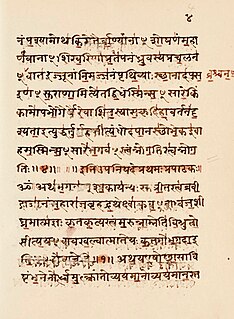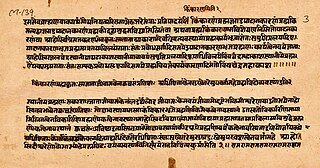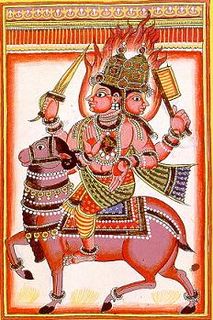The Aranyakas constitutes the philosophy behind ritual sacrifice of the ancient Hindu sacred texts, the Vedas. They typically represent the later sections of Vedas, and are one of many layers of the Vedic texts. The other parts of Vedas are the Samhitas, Brahmanas (commentary), and the Upanishads.

The Maitrayaniya Upanishad is an ancient Sanskrit text that is embedded inside the Yajurveda. It is also known as the Maitri Upanishad, and is listed as number 24 in the Muktika canon of 108 Upanishads.

The Yajurveda is the Veda primarily of prose mantras for worship rituals. An ancient Vedic Sanskrit text, it is a compilation of ritual-offering formulas that were said by a priest while an individual performed ritual actions such as those before the yajna fire. Yajurveda is one of the four Vedas, and one of the scriptures of Hinduism. The exact century of Yajurveda's composition is unknown, and estimated by Witzel to be between 1200 to 800 BCE, contemporaneous with Samaveda and Atharvaveda.

The Brihadaranyaka Upanishad is one of the Principal Upanishads and one of the first Upanishadic scriptures of Hinduism. A key scripture to various schools of Hinduism, the Brihadaranyaka Upanisad is tenth in the Muktikā or "canon of 108 Upanishads".

The Isha Upanishad is one of the shortest Upanishads, embedded as the final chapter (adhyāya) of the Shukla Yajurveda. It is a Mukhya Upanishad, and is known in two recensions, called Kanva (VSK) and Madhyandina (VSM). The Upanishad is a brief poem, consisting of 17 or 18 verses, depending on the recension.

The Shvetashvatara Upanishad is an ancient Sanskrit text embedded in the Yajurveda. It is listed as number 14 in the Muktika canon of 108 Upanishads. The Upanishad contains 113 mantras or verses in six chapters.
The Tree of Jiva and Atman appears in the Vedic scriptures concerning the soul.
The following is a glossary of terms and concepts in Hinduism. The list consists of concepts that are derived from both Hinduism and Hindu tradition, which are expressed as words in Sanskrit as well as other languages of India.

The Katha Upanishad is one of the mukhya (primary) Upanishads, embedded in the last short eight sections of the Kaṭha school of the Krishna Yajurveda. It is also known as Kāṭhaka Upanishad, and is listed as number 3 in the Muktika canon of 108 Upanishads.

In Hinduism, Yama - also referred to as Yamaraja - is a Rigvedic deity. He is the lord of death and justice, being responsible for the dispensation of law and punishment of sinners in his abode, Yamaloka. He is accompanied by Chitragupta.
Nachiketa, also known as Nachiketā, or Nachiketas or sometimes even Nachiketan was the son of the sage Vājashravas also known as Vājashravā is the child protagonist in an ancient Indian story about the nature of the soul and the power of a spiritual, determined and steadfast boy who was as spirited as his sage father. The story is told in the Katha Upanishad, though the name has several earlier references. He was taught self-knowledge, the separation of the human soul from the body, by the god of Death, Yama. Nachiketa is noted for his rejection of material desires which are ephemeral, and for his single-minded pursuit of the path of realizing salvation/Moksha i.e. emancipation of the soul from rebirth.
Aruni, also referred to as Uddalaka or Uddalaka Aruni or Uddalaka Varuni, is a revered Vedic sage of Hinduism. He is mentioned in many Vedic era Sanskrit texts, and his philosophical teachings are among the center piece in the Brihadaranyaka Upanishad and Chandogya Upanishad, two of the oldest Upanishadic scriptures. A famed Vedic teacher, Aruni lived a few centuries before the Buddha, and attracted students from far regions of the Indian subcontinent; some of his students such as Yajnavalkya are also highly revered in the Hindu traditions. Both Aruni and Yajnavalkya are among the most frequently mentioned Upanishadic teachers in Hinduism.

Essence of the Upanishads is a translation and commentary on the Katha Upanishad, an ancient Indian scripture. Written by Eknath Easwaran, the book was originally published in the United States in 1981, entitled Dialogue With Death. Foreign (non-English) editions have also been published in several languages. The book has been reviewed in newspapers, magazines, and elsewhere.
Paramananda is a compound Sanskrit word composed of two words, Parama and Ānanda. Parma is usually taken to mean the Highest, the utmost or the most excellent, but actually means - "beyond". And Ānanda, which means, happiness and bliss and most often used to refer to joy though it does not exactly mean these because the original meaning implies permanence rather than just a momentary surge of delight or happiness; it also suggests a deep-seated spiritual emotion that is solidly entrenched. The Upanishadic Seers have used the word, Ānanda, to denote Brahman, the limitless, formless, infinite, indestructible, sole eternal Supreme Being or Sole Reality, to mean, Brahmanmayah, i.e. full of Brahman.
Ratha Kalpana is a metaphor used in Hindu scriptures to describe the relationship between the senses, mind, intellect and the Self. The metaphor was first used in the Katha Upanishad and is thought to have inspired similar descriptions in the Bhagavad Gita, the Dhammapada and Plato's Phaedrus. Gerald James Larson, a scholar of Indian philosophies, believes that the chariot metaphor contains one of the earliest references to ideas and terminology of the Indian philosophical school Samkhya.
Sakayanya, also known as Jata Sakayanya, a descendant of Saka, was a ritual authority and contemporary of Sankha in the Kathaka Samhita (xxii.70) also known as Charaka Samhita belonging to Krishna Yajurveda, and which was compiled by Katha, a disciple of Vaisampayana.
Trishna means – 'thirst', 'aspiration', 'longing', 'craving' or 'lusty desires', or as तृष्णज् meaning covetous, greedy or thirsting. Trishna is the Eighth Nidana, spiritual love.

The Kaivalya Upanishad is an ancient Sanskrit text and one of the minor Upanishads of Hinduism. It is classified as a Shaiva Upanishad, and survives into the modern times in two versions, one attached to the Krishna Yajurveda and other attached to the Atharvaveda. It is, as an Upanishad, a part of the corpus of Vedanta literature collection that present the philosophical concepts of Hinduism.

Agni is a Sanskrit word meaning fire and connotes the Vedic fire god of Hinduism. He is also the guardian deity of the southeast direction and is typically found in southeast corners of Hindu temples. In the classical cosmology of the Indian religions, Agni as fire is one of the five inert impermanent elements (pañcabhūtá) along with space (ākāśa), water (ap), air (vāyu) and earth (pṛthvī), the five combining to form the empirically perceived material existence (Prakriti).

The Maitreya Upanishad is one of the minor Upanishads of Hinduism. Composed in Sanskrit, it is one of the 16 Upanishads that belongs to the Samaveda, is classified as one of the 20 Sannyasa (Renunciation) Upanishads, and is one of the Vedanta Upanishads. The text is listed at 29 in the serial order in the Muktika enumerated by Rama to Hanuman in the modern era anthology of 108 Upanishads.










